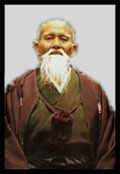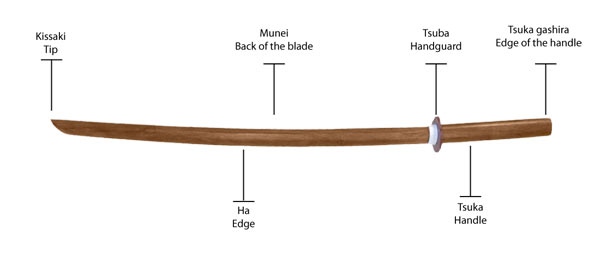Weapons
There are basically two weapons of Aikido, the wooden sword (bokken) and the wooden staff (jo). On occasion, and especially in the context of disarming exercises, the wooden dagger is used (tanto). Tanto techniques are rarely taught.
Bokken
The sword, bokken, (which in other martial arts is also called bokuto) is made from various types of wood, with rosewood, hickory and kasha (white Japanese oak) being the most frequent. Kasha is more suitable as it is not damaged by blows and is more durable.
The shape and size of the bokken is the same as the large Japanese sword katana -this means that it is convex and is sharpened only on one side. However, as in the case of real swords, the depth of its curvature, its weight and the length of its "cut" varies between designs.
A good rule for choosing a bokken is not to have wood calluses (which indicate a weakness of the wood at the specific point), to have a dense grainy texture of wood, and to exhibit a straight shape when viewed from top side. Also important is the cutting feel, although for this to be appreciated the buyer should have some experience. The perfect feel is to have a good "weight", to end during the vertical cut, and not to "pull" the hands of the practitioner further down.
The usual weight of a bokken is between 750g and 900g, while a steel sword exceeds 1 kg. As for the length, a good way to estimate this in relation to the size of the practitioner is the following: the practitioner holds the sword with the right hand, one finger width below the height of the cross guard (tsuba), and allows his hand to move softly down. If the nose of the sword touches the ground about 10cm in front of his left leg it is at an acceptable length. The most frequent length for the cut is from 73cm to 77cm, and counting is done in a straight line from the top side of the cross guard to the tip of the sword.
As the bokken derives from the standard sword, each of its parts has its own terminology. Its basic parts and terms are given below.
The bokken is used in Aikido:
a) In single set patterns (kata), where the trainee moves alone in line within a specific pattern of movements
b) In set patterns in pairs (kumi-tachi), where two trainees move in line within a specific pattern of movements
c) In disarming techniques (tachi-dori), where the attacker is armed with the bokken and the defender executes techniques to disarm him
d) In defense techniques with bokken (tachi/bokken/nage), where the bokken is in the hands of the defender and the attacker fails to disarm him
e) As a means of training in a numerous unarmed techniques
In order to achieve a good relation with the bokken, in most Aikido schools significant time is devoted to its tuition, with cutting exercises (suburi),
body movements (tai-sabaki), assessment of distance (maai), etc.
Jo
The staff, jo, (which the founder of Aikido, Morihei Ueshiba, frequently used) is the second important weapon of the art. It is also made from different types of wood with rosewood, hickory and kashi (white Japanese oak) being the most frequent; the latter being preferred due to the resistance and thickness of the grain. It is straight and cylindrical at each end, its length is usually from 120cm to 140cm, its diameter is from 2,3cm to 2,5cm and its weight varies, and is most frequently between 600g to 800g.
For the selection of the jo the practitioner must consider, as with the bokken, the quality of the wood (density of the grain, absence of wood calluses etc) as well as the straightness of the weapon - a good way to check this is to place the jo on a flat surface and to roll it. A straight jo will roll smoothly while one which has even the smallest bump will exhibit an abnormal movement and noise. Regarding the length, an easy way to evaluate this is to place the jo vertically in line and next to the body with one end precisely next to the foot -if the other end reaches the curve of the armpit of the trainee then most probably it is at a suitable length.
The jo is used in Aikido:
a) In single set patterns (kata), where the trainee moves alone in line within a specific pattern of movements
b) In set patterns in pairs (kumi-jo), where two trainees move in line within a specific pattern of movements
c) In disarming techniques (jo-dori), where the attacker is armed with the jo and the defender executes techniques to disarm him
d) In defense techniques with jo (jo-nage), where the jo is in the hands of the defender and the attacker fails to disarm him
As is the case with the bokken, in order to achieve a good relation with the jo, there are exercises with this weapon which are either strikes (suburi),
body movements (tai-sabaki), assessment of distance (maai), etc.
Tanto
The Tando which is used in Aikido is a copy of the steel dagger, which is the third in the family of swords of the classic Japanese warrior (the other two are the katana and the wakizashi). Its shape follows the shape of the steel tando (with a slight curve and cut on one side) and its length varies from 20cm to 25cm. As the tando is used mainly in disarming techniques (tantdo-dori) the recommendations for selection of wood etc are not applicable. However, this is also customarily made from the popular wood types used for weapons, of rosemary, hickory and kashi (white Japanese oak).





 FukuShinKan Dojo, 12 Davaki st.and 18 Mylpotamou st., 1st floor
FukuShinKan Dojo, 12 Davaki st.and 18 Mylpotamou st., 1st floor Hellenic Aikido Association on facebook
Hellenic Aikido Association on facebook Hellenic Aikido Association's YouTube channel
Hellenic Aikido Association's YouTube channel